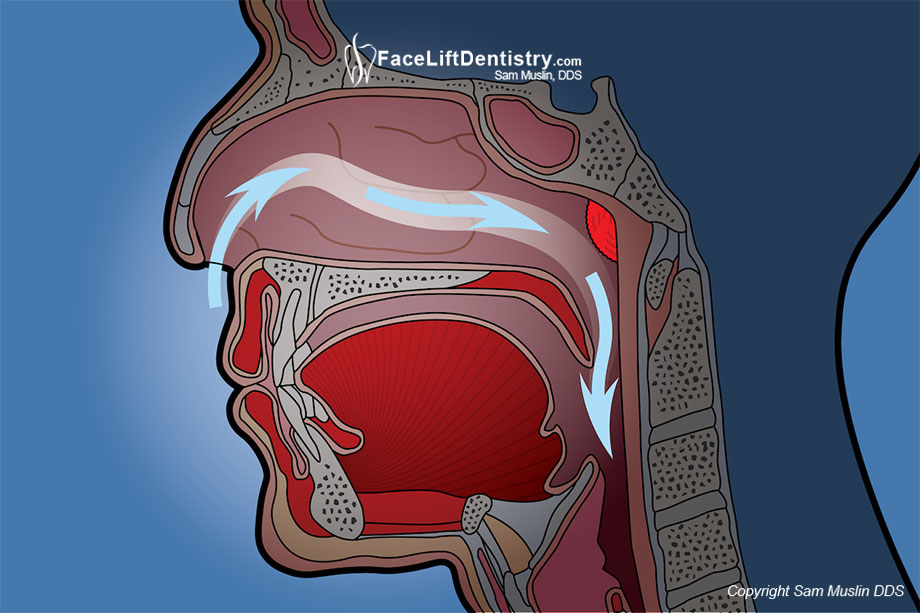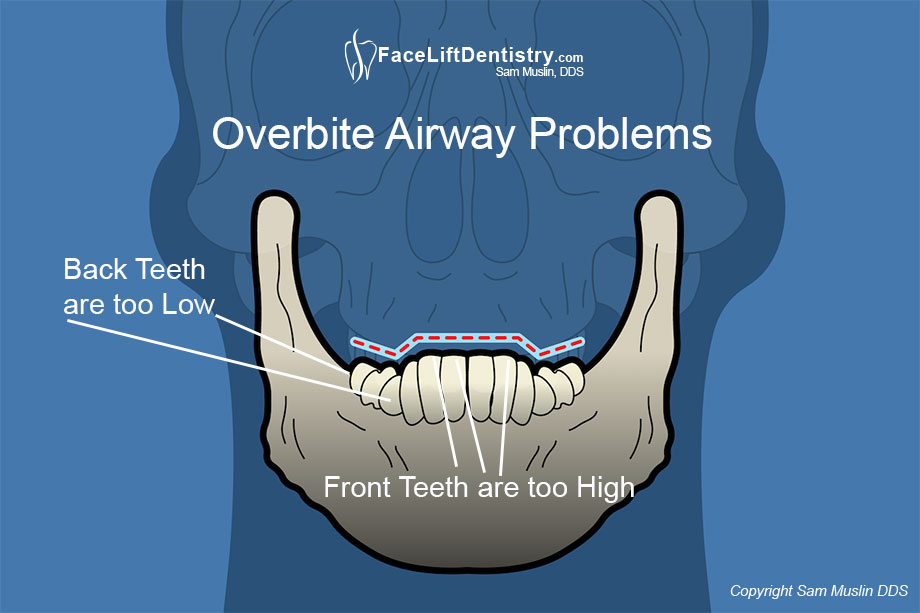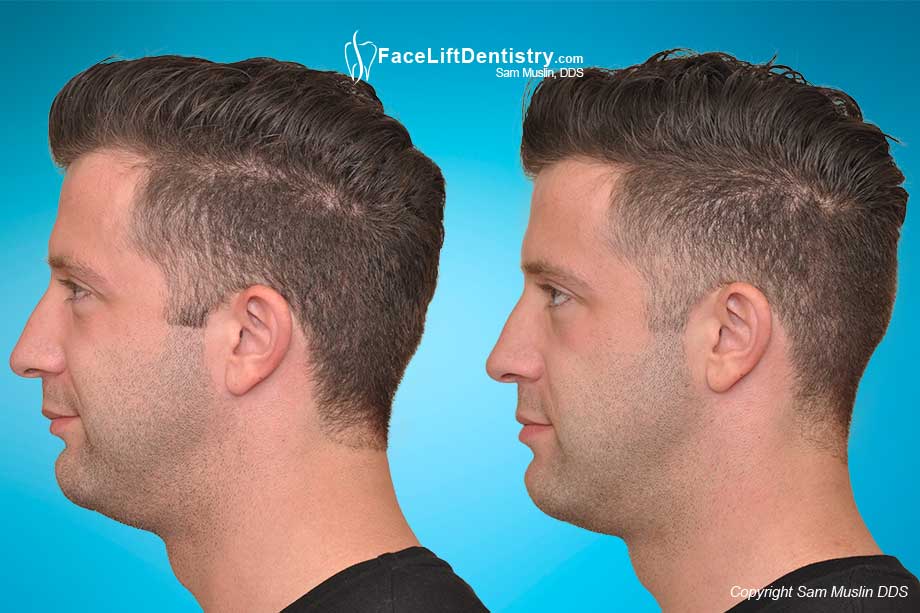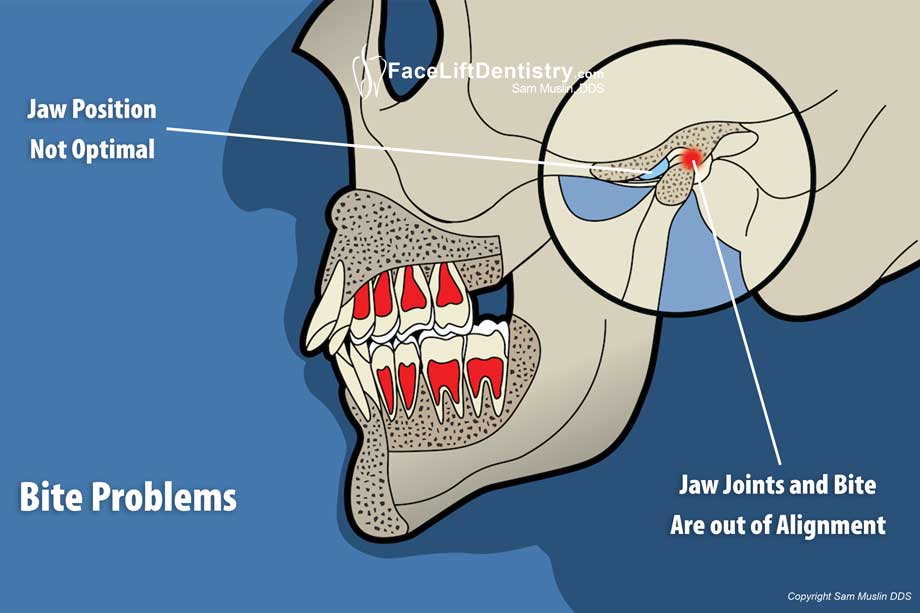No Drilling Jaw Alignment with Significant Cosmetic and Health Benefits Simultaneously
Medically Reviewed by Sam Muslin, DDS, MAGD | Last Updated on 03/20/2023
The key to a healthy airway for better breathing is to be physically able to have an airway passage that is large enough to accommodate normal breathing. In the example below, this patient is able to breathe normally. The lower jaw is in a normal position, which allows the airway passage to be a normal size.

A normal jaw position and airway passage
When we breathe well, we have a normal blood oxygen level during the night. When we don't breathe well, our blood oxygen can be lower and this causes organ stress. When our internal organs do not get enough oxygen, we can physically suffer. Some of us will wake up grumpy. Others will wake up during the night too often. The quality of our sleep is directly related to our ability to breathe well.
The position of our lower jaw is determined by our bite. When a patient has an overbite, the lower jaw is pushed back and the physical size of the airway can be reduced. The typical overbite has front teeth that are too high and back teeth that are too low. This results in the lower jaw-closing too far and the lower jaw is pushed back due to the positions of the teeth.

Overbites can cause the lower jaw to be pushed back, reducing tongue space and impacting the airway
When the back teeth are too low, there usually is not enough space for the tongue to function normally. Consequently, patients can snore more often, have reduced sleeping efficiency, wake up too often and suffer from a low blood oxygen level when sleeping and even when awake. These patients can age more quickly from a physical and cosmetic perspective. Facial collapse is very common with deep overbites and small looking chins.
Bite correction using JawTrac® can help locate the most ideal jaw position and test that position for improved breathing. Testing before treating is the key to success. Then, VENLAY® Bite Restorations can maintain that new jaw position and improve your facial profile at the same time without drilling down your healthy teeth. JawTrac®, VENLAY® bite restorations are not separate procedures as they are part of the Face Lift Dentistry® Method.

When the jaw position is not ideal, breathing can be compromised.
Overbites, underbites, misaligned jaws, TMJ problems and worn down teeth contribute to breathing difficulties. Correcting malocclusions can improve the position of the lower jaw, improve our facial profiles, provide more space for our tongues and at the same time improve the airway passage without throat surgery, jaw surgery, braces, years of treatment and give is straight white teeth. The patient above had porcelain veneers which do nothing for our airway passage, chin size, jaw comfort, and blood oxygen level.

This untouched and unaltered photo demonstrates managing airway development and craniofacial formation through the relationship between Airway, Breathing, and Malocclusion. This patient had a deep overbite, with his jaw pushed back, low back teeth and high front teeth.
When the jaw position is optimized to the natural structural anatomy of the patient the functionality of the craniofacial formation is improved. When his small looking chin is repositioned, it is much larger in appearance. No chin implants or chin augmentation was needed. The airway and breathing can be improved when the malocclusion is corrected using the Face LIft Dentistry® Method which does not cut or drill away your healthy teeth.
This treatment method is designed to accomplish an improve airway without throat surgery. Sometimes throat surgery is the better method but malocclusion correction can provide an adequate airway passage improvement faster, safer and more predictable. With JawTrac® testing our patients can experience the benefits and decide if they want to move forward. You cannot test throat surgery.

Malocclusion correction can also improve TMJ functionality while also improving breathing
The physical and mental benefits of optimizing the lower jaw position through bite optimization can reverse the impact of premature aging. Cosmetic dentistry can give you white teeth after they are drilled down but anti-aging Face Lift Dentistry® can take your care to a higher level without jaw surgery, braces, and especially without drilling away your healthy teeth. Call for your appointment because the only way for this doctor to help you is to see you. Our patients will tell you, "it is worth getting on a plane."
Face Lift Dentistry® Is The Future of Bite Correction
Face Lift Dentistry® not only optimizes your smile, but it also optimizes your entire face! Call today and get ready to change your life. Face Lift Dentistry® results are Safer, More Reliable, Testable, and Far More Predictable Healthcare with enormous Cosmetic Impact.
Contact UsFace Lift Dentistry® fee is $40,000 per upper or lower arch plus any additional dental work such as fillings, gum work, dental implants, etc. Most patients get both the upper and the lower arches done simultaneously to maximize their results and get the most health benefits possible. Face Lift Dentistry® is dental health care that is tax deductible depending on your income, so we advise that you check with your accountant.
